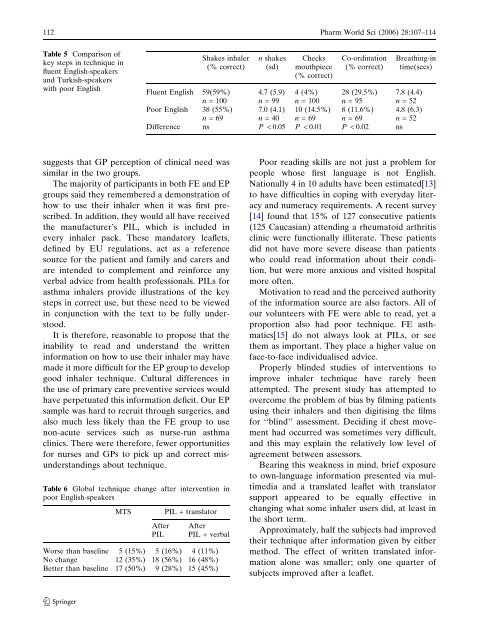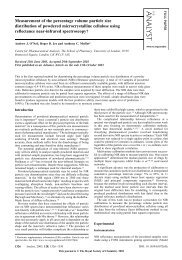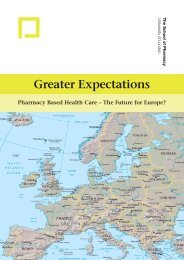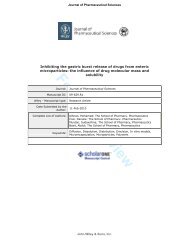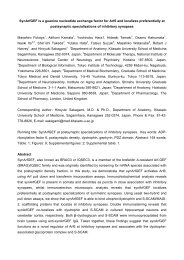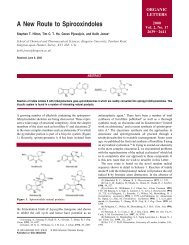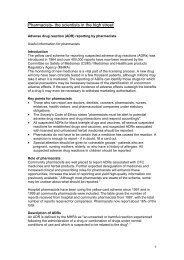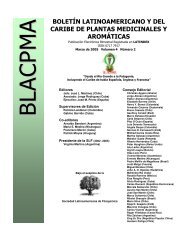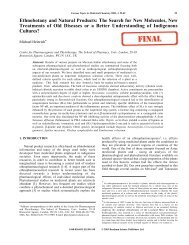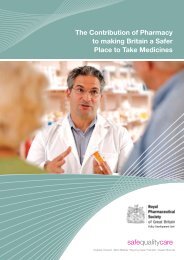Inhaler technique in Turkish people with poor English: a case of ...
Inhaler technique in Turkish people with poor English: a case of ...
Inhaler technique in Turkish people with poor English: a case of ...
You also want an ePaper? Increase the reach of your titles
YUMPU automatically turns print PDFs into web optimized ePapers that Google loves.
112 Pharm World Sci (2006) 28:107–114<br />
Table 5 Comparison <strong>of</strong><br />
key steps <strong>in</strong> <strong>technique</strong> <strong>in</strong><br />
fluent <strong>English</strong>-speakers<br />
and <strong>Turkish</strong>-speakers<br />
<strong>with</strong> <strong>poor</strong> <strong>English</strong><br />
Shakes <strong>in</strong>haler<br />
(% correct)<br />
suggests that GP perception <strong>of</strong> cl<strong>in</strong>ical need was<br />
similar <strong>in</strong> the two groups.<br />
The majority <strong>of</strong> participants <strong>in</strong> both FE and EP<br />
groups said they remembered a demonstration <strong>of</strong><br />
how to use their <strong>in</strong>haler when it was first prescribed.<br />
In addition, they would all have received<br />
the manufacturer’s PIL, which is <strong>in</strong>cluded <strong>in</strong><br />
every <strong>in</strong>haler pack. These mandatory leaflets,<br />
def<strong>in</strong>ed by EU regulations, act as a reference<br />
source for the patient and family and carers and<br />
are <strong>in</strong>tended to complement and re<strong>in</strong>force any<br />
verbal advice from health pr<strong>of</strong>essionals. PILs for<br />
asthma <strong>in</strong>halers provide illustrations <strong>of</strong> the key<br />
steps <strong>in</strong> correct use, but these need to be viewed<br />
<strong>in</strong> conjunction <strong>with</strong> the text to be fully understood.<br />
It is therefore, reasonable to propose that the<br />
<strong>in</strong>ability to read and understand the written<br />
<strong>in</strong>formation on how to use their <strong>in</strong>haler may have<br />
made it more difficult for the EP group to develop<br />
good <strong>in</strong>haler <strong>technique</strong>. Cultural differences <strong>in</strong><br />
the use <strong>of</strong> primary care preventive services would<br />
have perpetuated this <strong>in</strong>formation deficit. Our EP<br />
sample was hard to recruit through surgeries, and<br />
also much less likely than the FE group to use<br />
non-acute services such as nurse-run asthma<br />
cl<strong>in</strong>ics. There were therefore, fewer opportunities<br />
for nurses and GPs to pick up and correct misunderstand<strong>in</strong>gs<br />
about <strong>technique</strong>.<br />
Table 6 Global <strong>technique</strong> change after <strong>in</strong>tervention <strong>in</strong><br />
<strong>poor</strong> <strong>English</strong>-speakers<br />
n shakes<br />
(sd)<br />
Checks<br />
mouthpiece<br />
(% correct)<br />
Co-ord<strong>in</strong>ation<br />
(% correct)<br />
Breath<strong>in</strong>g-<strong>in</strong><br />
time(secs)<br />
Fluent <strong>English</strong> 59(59%) 4.7 (5.9) 4 (4%) 28 (29.5%) 7.8 (4.4)<br />
n = 100 n =99 n = 100 n =95 n =52<br />
Poor <strong>English</strong> 38 (55%) 7.0 (4.1) 10 (14.5%) 8 (11.6%) 4.8 (6.3)<br />
n =69 n =40 n =69 n =69 n =52<br />
Difference ns P < 0.05 P < 0.01 P < 0.02 ns<br />
MTS PIL + translator<br />
After<br />
PIL<br />
After<br />
PIL + verbal<br />
Worse than basel<strong>in</strong>e 5 (15%) 5 (16%) 4 (11%)<br />
No change 12 (35%) 18 (56%) 16 (48%)<br />
Better than basel<strong>in</strong>e 17 (50%) 9 (28%) 15 (45%)<br />
123<br />
Poor read<strong>in</strong>g skills are not just a problem for<br />
<strong>people</strong> whose first language is not <strong>English</strong>.<br />
Nationally 4 <strong>in</strong> 10 adults have been estimated[13]<br />
to have difficulties <strong>in</strong> cop<strong>in</strong>g <strong>with</strong> everyday literacy<br />
and numeracy requirements. A recent survey<br />
[14] found that 15% <strong>of</strong> 127 consecutive patients<br />
(125 Caucasian) attend<strong>in</strong>g a rheumatoid arthritis<br />
cl<strong>in</strong>ic were functionally illiterate. These patients<br />
did not have more severe disease than patients<br />
who could read <strong>in</strong>formation about their condition,<br />
but were more anxious and visited hospital<br />
more <strong>of</strong>ten.<br />
Motivation to read and the perceived authority<br />
<strong>of</strong> the <strong>in</strong>formation source are also factors. All <strong>of</strong><br />
our volunteers <strong>with</strong> FE were able to read, yet a<br />
proportion also had <strong>poor</strong> <strong>technique</strong>. FE asthmatics[15]<br />
do not always look at PILs, or see<br />
them as important. They place a higher value on<br />
face-to-face <strong>in</strong>dividualised advice.<br />
Properly bl<strong>in</strong>ded studies <strong>of</strong> <strong>in</strong>terventions to<br />
improve <strong>in</strong>haler <strong>technique</strong> have rarely been<br />
attempted. The present study has attempted to<br />
overcome the problem <strong>of</strong> bias by film<strong>in</strong>g patients<br />
us<strong>in</strong>g their <strong>in</strong>halers and then digitis<strong>in</strong>g the films<br />
for ‘‘bl<strong>in</strong>d’’ assessment. Decid<strong>in</strong>g if chest movement<br />
had occurred was sometimes very difficult,<br />
and this may expla<strong>in</strong> the relatively low level <strong>of</strong><br />
agreement between assessors.<br />
Bear<strong>in</strong>g this weakness <strong>in</strong> m<strong>in</strong>d, brief exposure<br />
to own-language <strong>in</strong>formation presented via multimedia<br />
and a translated leaflet <strong>with</strong> translator<br />
support appeared to be equally effective <strong>in</strong><br />
chang<strong>in</strong>g what some <strong>in</strong>haler users did, at least <strong>in</strong><br />
the short term.<br />
Approximately, half the subjects had improved<br />
their <strong>technique</strong> after <strong>in</strong>formation given by either<br />
method. The effect <strong>of</strong> written translated <strong>in</strong>formation<br />
alone was smaller; only one quarter <strong>of</strong><br />
subjects improved after a leaflet.


